
CURATOR’s EYE
What is art in the age of traveling to the stars?
Follow TRiCERA on Instagram and check out our creative artists
5%OFF & free shipping 1st purchase
FIRSTART5
10%OFF 2nd purchase after 1st purchase!
Welcome to TRiCERA
Hi there! We are pleased to have you here 🎉
Could you please describe yourself?
Guest
Famous paintings from around the world that are housed in museums.
Have you ever wondered why they are famous? Have you ever wondered why they are famous?
In " 10 Famous Paintings of the World ", we introduced famous Western paintings from the 15th century to the early 20th century.
In this issue, we will introduce 10 famous contemporary paintings in more depth from famous museums around the world.
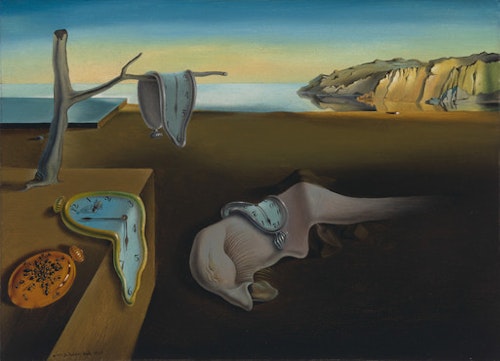
Salvador Dali is a representative Surrealist painter who creates unrealistic paintings by combining impossible motifs.
One of his best-known works is "The Adhesion of Memory," shown here.
Published in 1931, when Dali was 27 years old, this relatively early work already offers a glimpse of his characteristic desert scenes and unique motifs such as melted and deformed clocks and other strange objects.
The work is now in the collection of the Museum of Modern Art (MoMA) in New York and is considered one of the most important paintings of 20th century art.
At first glance, the motifs may seem unintelligible, but in fact, each individual motif in the painting has a hidden symbolic meaning.
It is said that Dali was inspired to create the image of a "melting clock" one day when he saw a piece of Camembert cheese left uneaten by Gala, Dali's partner and model, in the kitchen, in a state of melting.
Normally, a clock is a hard object and is supposed to mark time regularly.
By having it melt and distort like a piece of cheese, it is thought that Dali is expressing a distortion of time and space.
Einstein published his "General Theory of Relativity" in 1915. It is thought that Dali may have been influenced by the idea that time and space are relative and can appear distorted depending on one's point of view, which was gradually becoming popular among the public.
In addition, the mysterious white, dumpling-skin-like object lying in the center of the painting symbolizes Dali's latent imagery. Physical and sexual arousal and its decline or collapse. It is thought that this mysterious object is a form of this.
And the orange clock in the foreground, on the left, where ants gather, may represent the concept of "decay.
Each element in Dali's paintings is a symbol of his own desires and innovative ideas of the time, and the more you read and understand them, the more enjoyable they become.
.jpg?w=500&h=371)
The famous Impressionist painter Pierre-Auguste-Renoir painted "The Ball at Moulin de la Galette" in 1876.
The Moulin de la Galette was an outdoor dance hall in Montmartre, an area of Paris where cultural figures gathered.
Incidentally, "Galette" means "windmill," and its distinctive windmill was a landmark.
This painting was exhibited at the Third Impressionist Exhibition in 1877 and is now housed in the Musée d'Orsay in Paris.
This joyful painting, modeled after Renoir's own friends, depicts the sunlight filtering through the trees casting beautiful patterns on the people, and the rich expressions on the faces of those who are enjoying dancing and getting tipsy.
This painting, one of Renoir's most popular and most popular Impressionist works, is available in two versions: the large version shown above (131 cm x 175 cm) and a smaller, sketch-sized version painted on site.
The large version of the main painting was sold to Ryoei Saito, honorary chairman of Daishowa Paper Company (now Nippon Paper Industries), for $78 million (the second highest price ever paid for a painting) in 1990, at the end of the bubble economy (it is said that after the bubble burst, the painting passed to a collector in Switzerland).
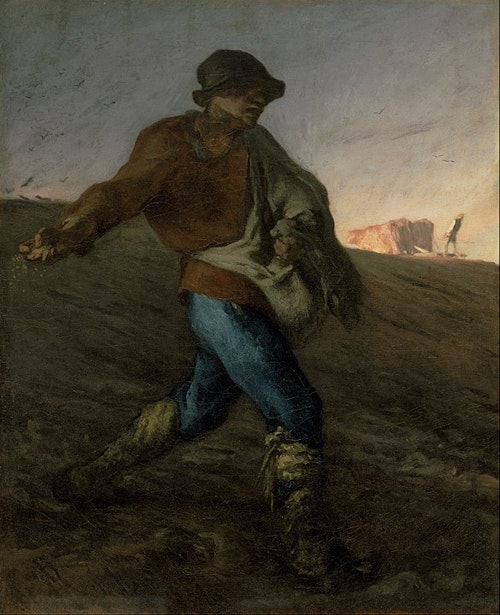
Jean-François Millet's "The Sower" is a painting characterized by the strength of its depiction of a farmer who sows seeds and survives.
Painted in 1850, the painting is now in the collection of the Museum of Fine Arts, Boston, USA, and is one of the museum's main attractions.
When the painting was exhibited at the Salon (government exhibition) in Paris in 1850, it is said to have provoked heated debate, as many people saw it as a political statement protesting the miserable lives of the peasants.
At the time, France was in the midst of a growing conflict between the peasant and working classes, which had increased their political voice with the February Revolution and universal suffrage, and the bourgeoisie, which was trying to suppress this threat.
As a result, conservatives accused Millet of being the same kind of scoundrels called "peasants," while those on the left raised him as the personification of the people of our time. These two extremes of evaluation give us a sense of the fundamental power of this work, which had the ability to appeal to the various classes of French people of the time.
In terms of technique, he was also innovative in that he applied thick coats of paint, which is frowned upon in academic painting techniques.
The critic Théophile Gauthier described it as "with its wild gestures and hideously crude becoming, the figure appears to be painted in the color of the soil in which the seeds are sown."
Along with Millet, who depicted political and social realities, the same period saw the emergence of Réalist painters such as Courbet and Daumier, and it can be said that this was a revolution in art history, a departure from the idealistic paintings of the past.
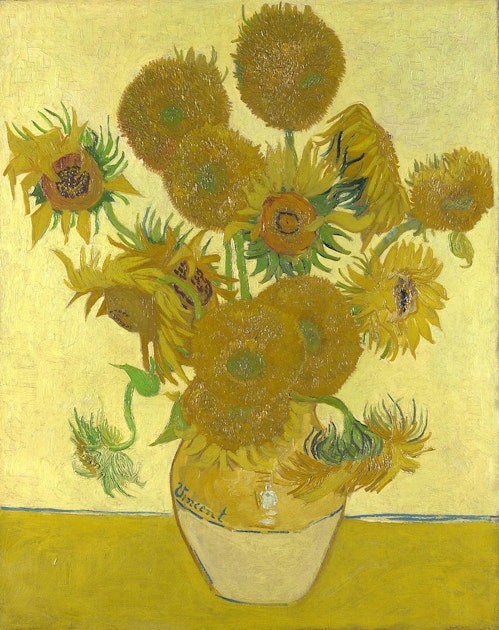
Everyone has seen Van Gogh's "Sunflowers" in textbooks or posters at least once.
In fact, there are a total of 10 existing "Sunflowers" that are recognized as having been painted by Van Gogh.
Each of them is called the "00 version" after the location of the museum where it is housed, and the "Sunflowers" in the above image is the "National Gallery version" owned by the National Gallery of Art in London.
This work was painted in 1888.
Van Gogh concentrated on sunflowers several times during his career, and this one was painted in Arles, in the south of France, a region of warmth and beautiful light.
The sunflowers are arranged in a simple composition, almost spilling out of the vase, against a background of bright yellow, the same color as the sunflowers.
The work evokes the cycle of life, with the taut dynamism of the sunflowers coexisting with the downward-facing wilting ones.
Incidentally, this work was the victim of a tomato can thrown at it in October 2022 by an environmentalist with the "Just Stop Oil" campaign.
The two activists were arrested, the work was cleaned up, and returned to the gallery that day.
The incident has made us think once again about how we should deal with and protect historical works of art.
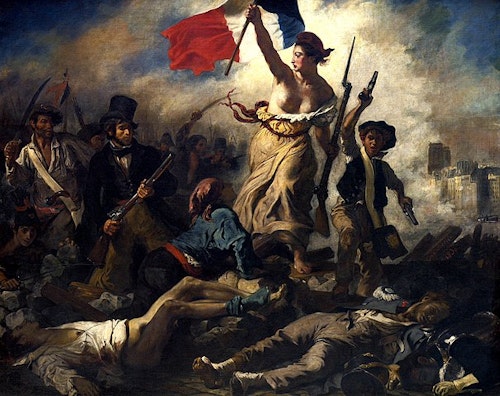
This painting is based on the motif of the "July Revolution" that took place in 1830 by Eugène Delacroix, a leading Romantic painter.
The woman in the center of the painting, holding a gun in her left hand and a French flag in her right, is a representative example of the symbolic French female figure known as "Marianne" leading the people.
Marianne herself symbolizes "freedom," and her one exposed breast symbolizes "motherhood = motherland," making this an allegorical painting.
With its dynamic, moving composition and theatrical theme, the painting is considered a representative work of the Romantic art movement.
Since its acquisition in 1874, it has been the centerpiece of the Louvre's collection and has attracted the attention of people around the world.
Delacroix also produced other dramatic paintings based on historical events, such as "The Massacre on the Island of Chios.
Reference work: The Massacre on the Island of Chios (1823-24, Louvre)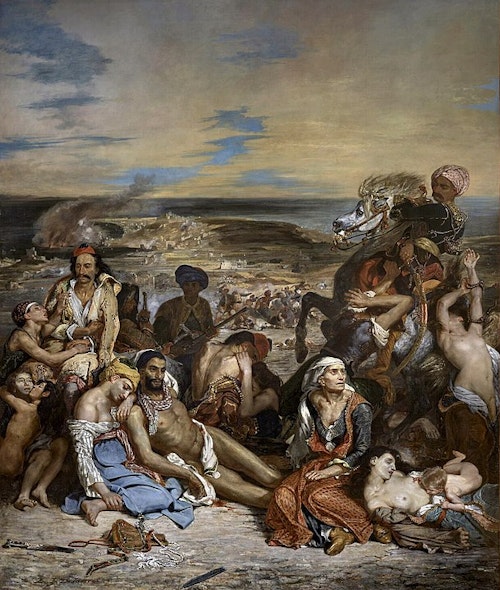
.jpg?w=500&h=918)
Saturn Devouring His Own Son is a painting by the Spanish artist Francisco de Goya, one of a series of paintings in his "Black Paintings.
Its shocking subject matter and the direct title and visuals that directly express its content make it an unforgettable work upon first viewing.
The work is believed to have been painted between 1819 and 1823 and is currently in the collection of the Museo del Prado in Madrid, Spain.
The painting is based on a mythological theme.
It depicts the legend that Saturn, the god of agricultural fertility in Roman mythology (corresponding to Cronus in Greek mythology), was so terrified by a prophecy that he would be killed by his own children that he swallowed his five children one after the other.
Saturn was originally the king of Mount Olympus, the home of the gods, but in his old age, Saturn's fear of his own destruction drove him to madness.
He bites his own son's head off and devours him to death, depicted with a sense of reality.
Many viewers are disgusted by the grotesque realism of the depiction.
At the same time, however, the directness of the depiction has made it a rare masterpiece in the history of art.
This painting is representative of the "Black Paintings" series, a series Goya painted in his later years. For a detailed explanation, please refer to the following article.
What is "Saturn Devouring His Child"? An explanation of Goya's masterpiece!
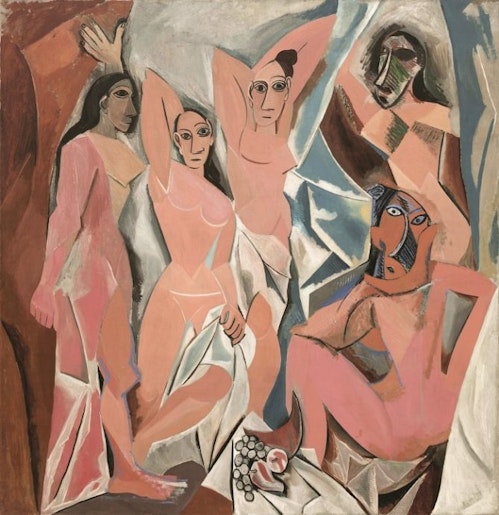
Pablo Picasso, one of the most famous painters in the world, painted "The Daughters of Avignon" at the age of 26, in 1907, at the beginning of his career.
The inspiration for this painting came from the "Avenue de Avignon" in Barcelona, Spain, a street lined with brothels.
The profile of the woman on the left is an ancient Egyptian sculpture, the two faces in the center are ancient Spanish sculpture, and the more characteristically distorted faces on the right are clearly influenced by African sculpture.
This work was the starting point for the art movement known as "Cubism," which was led by Picasso, Georges Braque, and others.
Cubism was not based on realism, such as perspective and realistic shading, but on the idea of deconstructing things and then reconstructing them in a new way that could only be achieved through painting.
This work is now in the collection of the Museum of Modern Art (MoMA) in New York.

Mondrian's abstract paintings have been loved throughout the ages, and their simplicity and modernist abstraction have influenced contemporary artists.
The ability to evoke emotion and sensation through simple lines, shapes, and colors was Mondrian's goal.
Immersed in studies of universal and emotional connections and theosophy, Mondrian also painted figuratively in his early years.
Gradually, influenced by cubism and other forms of art, he shifted to a minimalist style of expression.
This work, which reached the ultimate realm of minimalism, was created in 1930.
He left the following words: "I am a painter of line and color.
I build combinations of line and color on a flat surface. It is with the greatest concentration that I express universal beauty. Nature (or what I see) inspires me and gives me the urge to create something. But I want to get as close to the truth as possible and extract all the elements from it. And I want to reach the fundamentals that support it... even if they are still superficial.
I think it is possible to bring about harmony and rhythm by drawing horizontal and vertical lines with a clear will, but with a lofty intuition, not a calculating one. The strength and sanctity of those lines is that they are art."
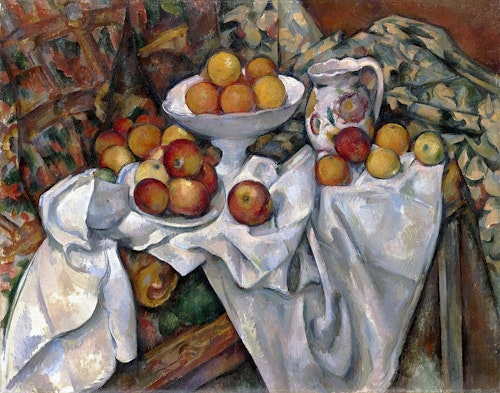
In this still life painting, created in 1899, we see distortions that are fraught with tension.
By placing motifs seen from various angles on the same picture plane, the effect can be seen, for example, in the discrepancy between the ridges of the table. This was later appreciated and developed by Cubism.
Gustave Geoffroy, a prominent art critic of the 19th century, recalled that Cézanne often said that he wanted to "surprise Paris with apples.
With this work, Cézanne radically destroyed the traditional methods of perspective and depiction.
The motif as a motive for painting "beautiful paintings."
Cézanne and Picasso, who followed Cézanne, thoroughly adopted such a way of thinking, and this concept has been passed down to the present day as the basic attitude in the creation of paintings.
.jpg?w=500&h=792)
This gigantic work, measuring 2 meters in height, is in the collection of the Louvre Museum in Paris.
In fact, another work with the exact same composition is in the collection of the National Gallery in London.
In this painting, the Virgin Mary, the Infant Christ, the young John the Baptist, and an angel are depicted against the backdrop of a rocky grotto.
The "sfumato" technique, a hallmark of Leonardo's painting, is on full display to depict the complexity and depth of space and the soft forms of the individual figures and their clothing.
It is believed to have been painted between 1483 and 1486, and research has revealed that it was originally one of the three central sets of paintings in the church altarpiece.
It depicts Christ gently embraced by the Virgin Mary and John the Baptist seated with angels in soft light.
The gentle atmosphere shared by the Mona Lisa, and the sense of unity of space that is maintained in the painting despite its elaborate detail, make this one of the most beautiful paintings of the Italian Renaissance, a period that was full of masterpieces.
Also read
Contemporary Art in All Its Varieties! Explanation of Contemporary Art by Genre
What is contemporary art all about? The more you know, the more interesting it is!
Who is Mondrian? An easy-to-understand explanation of the fascination of the founder of abstract painting!
What is Abstract Painting? A simple explanation of the history and famous artists!
Introducing 10 famous international painters who are hot right now! Contemporary Art
- Discounts such as members-only secret sales and coupons
- Create your own collection by registering your favorite artists
- Receive updates on popular artists, exhibitions, and events
- Receive a weekly newsletter with selected art
- Personal Assessment to find out what kind of art you like.
Please register as a member for free and receive the latest information.

Writer
TRiCERA ART
Famous paintings from around the world that are housed in museums.
Have you ever wondered why they are famous? Have you ever wondered why they are famous?
In " 10 Famous Paintings of the World ", we introduced famous Western paintings from the 15th century to the early 20th century.
In this issue, we will introduce 10 famous contemporary paintings in more depth from famous museums around the world.

Salvador Dali is a representative Surrealist painter who creates unrealistic paintings by combining impossible motifs.
One of his best-known works is "The Adhesion of Memory," shown here.
Published in 1931, when Dali was 27 years old, this relatively early work already offers a glimpse of his characteristic desert scenes and unique motifs such as melted and deformed clocks and other strange objects.
The work is now in the collection of the Museum of Modern Art (MoMA) in New York and is considered one of the most important paintings of 20th century art.
At first glance, the motifs may seem unintelligible, but in fact, each individual motif in the painting has a hidden symbolic meaning.
It is said that Dali was inspired to create the image of a "melting clock" one day when he saw a piece of Camembert cheese left uneaten by Gala, Dali's partner and model, in the kitchen, in a state of melting.
Normally, a clock is a hard object and is supposed to mark time regularly.
By having it melt and distort like a piece of cheese, it is thought that Dali is expressing a distortion of time and space.
Einstein published his "General Theory of Relativity" in 1915. It is thought that Dali may have been influenced by the idea that time and space are relative and can appear distorted depending on one's point of view, which was gradually becoming popular among the public.
In addition, the mysterious white, dumpling-skin-like object lying in the center of the painting symbolizes Dali's latent imagery. Physical and sexual arousal and its decline or collapse. It is thought that this mysterious object is a form of this.
And the orange clock in the foreground, on the left, where ants gather, may represent the concept of "decay.
Each element in Dali's paintings is a symbol of his own desires and innovative ideas of the time, and the more you read and understand them, the more enjoyable they become.
.jpg?w=500&h=371)
The famous Impressionist painter Pierre-Auguste-Renoir painted "The Ball at Moulin de la Galette" in 1876.
The Moulin de la Galette was an outdoor dance hall in Montmartre, an area of Paris where cultural figures gathered.
Incidentally, "Galette" means "windmill," and its distinctive windmill was a landmark.
This painting was exhibited at the Third Impressionist Exhibition in 1877 and is now housed in the Musée d'Orsay in Paris.
This joyful painting, modeled after Renoir's own friends, depicts the sunlight filtering through the trees casting beautiful patterns on the people, and the rich expressions on the faces of those who are enjoying dancing and getting tipsy.
This painting, one of Renoir's most popular and most popular Impressionist works, is available in two versions: the large version shown above (131 cm x 175 cm) and a smaller, sketch-sized version painted on site.
The large version of the main painting was sold to Ryoei Saito, honorary chairman of Daishowa Paper Company (now Nippon Paper Industries), for $78 million (the second highest price ever paid for a painting) in 1990, at the end of the bubble economy (it is said that after the bubble burst, the painting passed to a collector in Switzerland).

Jean-François Millet's "The Sower" is a painting characterized by the strength of its depiction of a farmer who sows seeds and survives.
Painted in 1850, the painting is now in the collection of the Museum of Fine Arts, Boston, USA, and is one of the museum's main attractions.
When the painting was exhibited at the Salon (government exhibition) in Paris in 1850, it is said to have provoked heated debate, as many people saw it as a political statement protesting the miserable lives of the peasants.
At the time, France was in the midst of a growing conflict between the peasant and working classes, which had increased their political voice with the February Revolution and universal suffrage, and the bourgeoisie, which was trying to suppress this threat.
As a result, conservatives accused Millet of being the same kind of scoundrels called "peasants," while those on the left raised him as the personification of the people of our time. These two extremes of evaluation give us a sense of the fundamental power of this work, which had the ability to appeal to the various classes of French people of the time.
In terms of technique, he was also innovative in that he applied thick coats of paint, which is frowned upon in academic painting techniques.
The critic Théophile Gauthier described it as "with its wild gestures and hideously crude becoming, the figure appears to be painted in the color of the soil in which the seeds are sown."
Along with Millet, who depicted political and social realities, the same period saw the emergence of Réalist painters such as Courbet and Daumier, and it can be said that this was a revolution in art history, a departure from the idealistic paintings of the past.

Everyone has seen Van Gogh's "Sunflowers" in textbooks or posters at least once.
In fact, there are a total of 10 existing "Sunflowers" that are recognized as having been painted by Van Gogh.
Each of them is called the "00 version" after the location of the museum where it is housed, and the "Sunflowers" in the above image is the "National Gallery version" owned by the National Gallery of Art in London.
This work was painted in 1888.
Van Gogh concentrated on sunflowers several times during his career, and this one was painted in Arles, in the south of France, a region of warmth and beautiful light.
The sunflowers are arranged in a simple composition, almost spilling out of the vase, against a background of bright yellow, the same color as the sunflowers.
The work evokes the cycle of life, with the taut dynamism of the sunflowers coexisting with the downward-facing wilting ones.
Incidentally, this work was the victim of a tomato can thrown at it in October 2022 by an environmentalist with the "Just Stop Oil" campaign.
The two activists were arrested, the work was cleaned up, and returned to the gallery that day.
The incident has made us think once again about how we should deal with and protect historical works of art.

This painting is based on the motif of the "July Revolution" that took place in 1830 by Eugène Delacroix, a leading Romantic painter.
The woman in the center of the painting, holding a gun in her left hand and a French flag in her right, is a representative example of the symbolic French female figure known as "Marianne" leading the people.
Marianne herself symbolizes "freedom," and her one exposed breast symbolizes "motherhood = motherland," making this an allegorical painting.
With its dynamic, moving composition and theatrical theme, the painting is considered a representative work of the Romantic art movement.
Since its acquisition in 1874, it has been the centerpiece of the Louvre's collection and has attracted the attention of people around the world.
Delacroix also produced other dramatic paintings based on historical events, such as "The Massacre on the Island of Chios.
Reference work: The Massacre on the Island of Chios (1823-24, Louvre)
.jpg?w=500&h=918)
Saturn Devouring His Own Son is a painting by the Spanish artist Francisco de Goya, one of a series of paintings in his "Black Paintings.
Its shocking subject matter and the direct title and visuals that directly express its content make it an unforgettable work upon first viewing.
The work is believed to have been painted between 1819 and 1823 and is currently in the collection of the Museo del Prado in Madrid, Spain.
The painting is based on a mythological theme.
It depicts the legend that Saturn, the god of agricultural fertility in Roman mythology (corresponding to Cronus in Greek mythology), was so terrified by a prophecy that he would be killed by his own children that he swallowed his five children one after the other.
Saturn was originally the king of Mount Olympus, the home of the gods, but in his old age, Saturn's fear of his own destruction drove him to madness.
He bites his own son's head off and devours him to death, depicted with a sense of reality.
Many viewers are disgusted by the grotesque realism of the depiction.
At the same time, however, the directness of the depiction has made it a rare masterpiece in the history of art.
This painting is representative of the "Black Paintings" series, a series Goya painted in his later years. For a detailed explanation, please refer to the following article.
What is "Saturn Devouring His Child"? An explanation of Goya's masterpiece!

Pablo Picasso, one of the most famous painters in the world, painted "The Daughters of Avignon" at the age of 26, in 1907, at the beginning of his career.
The inspiration for this painting came from the "Avenue de Avignon" in Barcelona, Spain, a street lined with brothels.
The profile of the woman on the left is an ancient Egyptian sculpture, the two faces in the center are ancient Spanish sculpture, and the more characteristically distorted faces on the right are clearly influenced by African sculpture.
This work was the starting point for the art movement known as "Cubism," which was led by Picasso, Georges Braque, and others.
Cubism was not based on realism, such as perspective and realistic shading, but on the idea of deconstructing things and then reconstructing them in a new way that could only be achieved through painting.
This work is now in the collection of the Museum of Modern Art (MoMA) in New York.

Mondrian's abstract paintings have been loved throughout the ages, and their simplicity and modernist abstraction have influenced contemporary artists.
The ability to evoke emotion and sensation through simple lines, shapes, and colors was Mondrian's goal.
Immersed in studies of universal and emotional connections and theosophy, Mondrian also painted figuratively in his early years.
Gradually, influenced by cubism and other forms of art, he shifted to a minimalist style of expression.
This work, which reached the ultimate realm of minimalism, was created in 1930.
He left the following words: "I am a painter of line and color.
I build combinations of line and color on a flat surface. It is with the greatest concentration that I express universal beauty. Nature (or what I see) inspires me and gives me the urge to create something. But I want to get as close to the truth as possible and extract all the elements from it. And I want to reach the fundamentals that support it... even if they are still superficial.
I think it is possible to bring about harmony and rhythm by drawing horizontal and vertical lines with a clear will, but with a lofty intuition, not a calculating one. The strength and sanctity of those lines is that they are art."

In this still life painting, created in 1899, we see distortions that are fraught with tension.
By placing motifs seen from various angles on the same picture plane, the effect can be seen, for example, in the discrepancy between the ridges of the table. This was later appreciated and developed by Cubism.
Gustave Geoffroy, a prominent art critic of the 19th century, recalled that Cézanne often said that he wanted to "surprise Paris with apples.
With this work, Cézanne radically destroyed the traditional methods of perspective and depiction.
The motif as a motive for painting "beautiful paintings."
Cézanne and Picasso, who followed Cézanne, thoroughly adopted such a way of thinking, and this concept has been passed down to the present day as the basic attitude in the creation of paintings.
.jpg?w=500&h=792)
This gigantic work, measuring 2 meters in height, is in the collection of the Louvre Museum in Paris.
In fact, another work with the exact same composition is in the collection of the National Gallery in London.
In this painting, the Virgin Mary, the Infant Christ, the young John the Baptist, and an angel are depicted against the backdrop of a rocky grotto.
The "sfumato" technique, a hallmark of Leonardo's painting, is on full display to depict the complexity and depth of space and the soft forms of the individual figures and their clothing.
It is believed to have been painted between 1483 and 1486, and research has revealed that it was originally one of the three central sets of paintings in the church altarpiece.
It depicts Christ gently embraced by the Virgin Mary and John the Baptist seated with angels in soft light.
The gentle atmosphere shared by the Mona Lisa, and the sense of unity of space that is maintained in the painting despite its elaborate detail, make this one of the most beautiful paintings of the Italian Renaissance, a period that was full of masterpieces.
Also read
Contemporary Art in All Its Varieties! Explanation of Contemporary Art by Genre
What is contemporary art all about? The more you know, the more interesting it is!
Who is Mondrian? An easy-to-understand explanation of the fascination of the founder of abstract painting!
What is Abstract Painting? A simple explanation of the history and famous artists!
Introducing 10 famous international painters who are hot right now! Contemporary Art
- Discounts such as members-only secret sales and coupons
- Create your own collection by registering your favorite artists
- Receive updates on popular artists, exhibitions, and events
- Receive a weekly newsletter with selected art
- Personal Assessment to find out what kind of art you like.
Please register as a member for free and receive the latest information.

Writer
TRiCERA ART